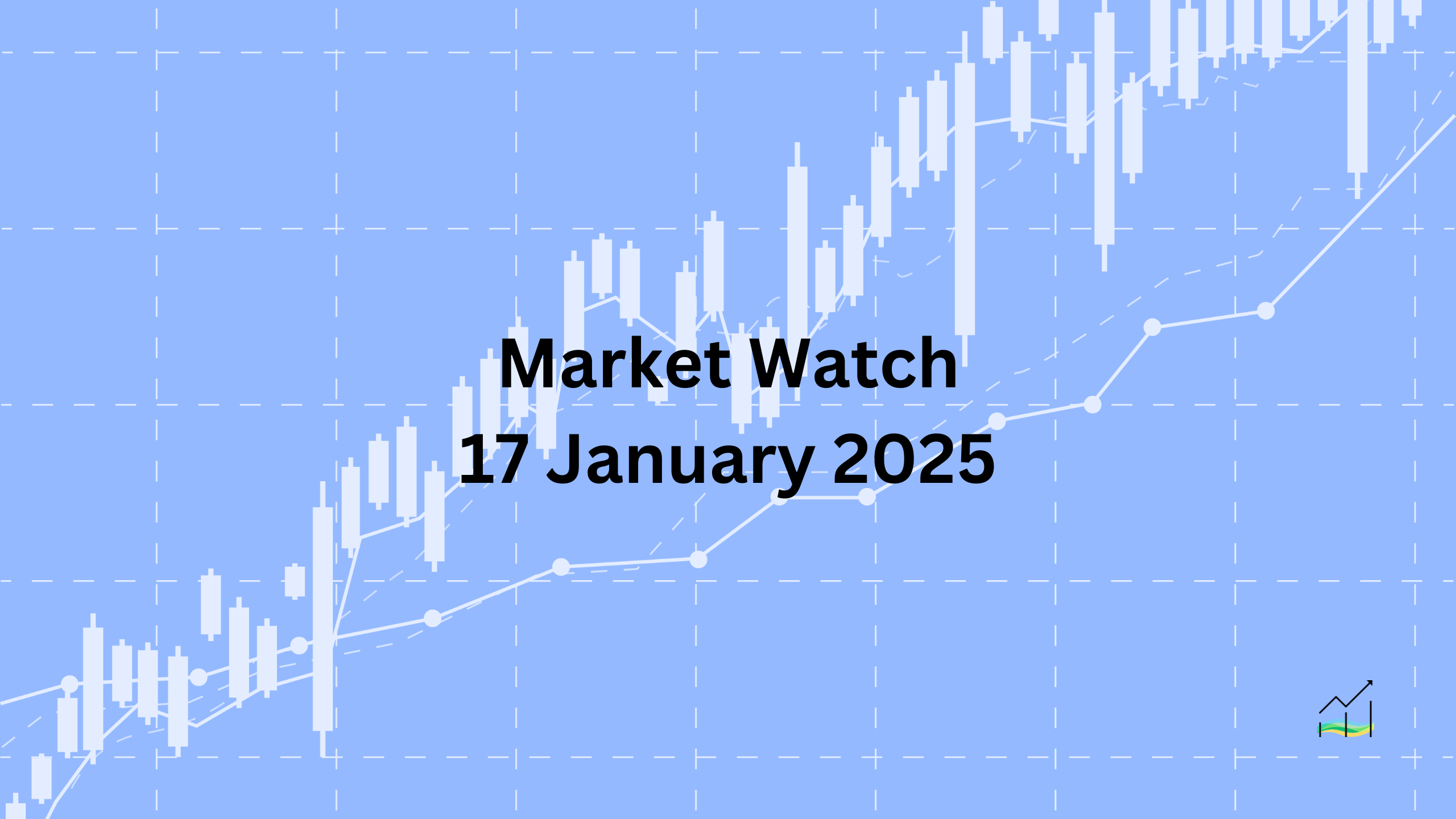17/01/2025 Market Watch

Market Watch: U.S. Dollar Strength and Global Economic Developments
The US dollar is showing strength against most G10 currencies, though the overall market tone remains one of consolidation. This comes ahead of significant events, including the inauguration of Donald Trump and the US markets' closure for the Martin Luther King holiday. There are broad warnings of immediate actions upon Trump's first day in office.
In currency movements, the Japanese yen is giving back some of its recent gains. However, the market is looking forward to a potential rate hike by the Bank of Japan next week. In the UK, retail sales data has capped a series of weaker economic indicators, and although the recent sell-off in UK Gilts has subsided, the British pound remains under pressure. Meanwhile, China’s Q4 GDP figures exceeded expectations, though skepticism about the accuracy of the data persists.
Equity markets in the Asia-Pacific region presented a mixed picture, but the MSCI regional index marked its first weekly gain of the year. In Europe, the Stoxx 600 has risen for the third session in a row, nearing a record high last seen in September. US index futures are also showing a firmer trend. Bond markets are following suit, with European benchmark yields dipping slightly and the 10-year US Treasury yield dropping below 4.60%, down from its peak of 4.80% earlier in the week.
Commodities are seeing a mix of movements. Gold prices are softening after a modest weekly advance, marking the third consecutive week of gains. Crude oil, with February WTI trading between $78.65 and $79.45, has achieved its fourth weekly gain, having settled at $76.60 last week.
United States of America
The Dollar Index reached session highs yesterday, slightly surpassing Wednesday’s peak following the retail sales report, but soon reversed to hit a new low near 108.80. Despite this, the market tone remains one of consolidation, with Thursday’s low at 108.60. The 20-day moving average, which the index has stayed above for a month, stands at approximately 108.75 today. As of now, the Dollar Index is trading within yesterday’s range, with the consolidation phase appearing constructive.
US markets will be closed on Monday in observance of Martin Luther King Day, coinciding with the presidential inauguration. In recent congressional discussions, Bessent emphasized concerns over the deficit trajectory, supported the independence of the Federal Reserve, and underscored the importance of the USD retaining its status as the primary reserve currency, though these remarks had minimal market impact.
Federal Reserve Governor Waller’s dovish remarks have gradually shifted market expectations for the next rate cut, which, after the latest US jobs data, has moved from being discounted until 2026 to almost fully anticipated by June. Last week, the probability stood at around 75%.
Economic data releases, including this week’s PPI and CPI, have contributed to forming a median expectation that the headline PCE deflator might have risen to 2.6% from 2.4%, with the core remaining steady at 2.8%. Today’s housing starts and industrial production figures are critical for shaping Q4 GDP estimates, which will be reported on January 30, following the conclusion of the FOMC meeting. Current estimates for Q4 GDP growth are around 3%.
Key Points:
- Dollar Index hit session highs before reversing to a new low, maintaining a consolidation tone.
- US markets closed on Monday for Martin Luther King Day and the presidential inauguration.
- Bessent’s remarks on deficit concerns, Fed independence, and USD’s reserve currency role had little market impact.
- Market expectations for the next Fed rate cut have shifted back to June.
- PPI and CPI suggest the headline PCE deflator may have accelerated, with the core stable.
- Housing starts and industrial production data will help finalize Q4 GDP estimates, expected around 3%.
Australia
The Australian dollar has rebounded from its lowest level since April 2020, around $0.6130, seen earlier this week. Over the past two sessions, it has faced resistance near $0.6250, finding support around $0.6190. Unless there is a significant setback in North American trading today, the Aussie’s six-week decline, its longest in a decade, appears to have ended.
The futures market still anticipates a rate cut by the Reserve Bank of Australia (RBA) next month, though the probability has dipped slightly from above 75% to about 66%. A key trendline from September’s high ($0.6940) and November’s high ($0.6690) intersects today near $0.6245 and will be just above $0.6200 by the end of next week.
Key Points:
- The Australian dollar bounced back from its lowest level since April 2020, stabilizing around $0.6190.
- Resistance was encountered near $0.6250, marking a potential end to a six-week decline.
- Futures markets still favor an RBA rate cut next month, but the probability has slightly decreased.
- A significant trendline from previous highs hovers around $0.6245 today and just above $0.6200 by next week.
Canada
The Canadian dollar has remained nearly unchanged for the week as of today’s session. Over the past eight sessions, the US dollar has been confined to a range set on January 6, between approximately CAD1.4280 and CAD1.4450. This week, it has stayed above CAD1.4300 and reached near the upper end of the range on Monday, even pushing past CAD1.4400 during European trading hours.
In the bond market, the US two-year yield premium over Canada, which had been narrowing for seven consecutive sessions, has widened over the past two days to around 127 basis points, slightly above last week’s level. Despite a four-week increase of about $10 per barrel in February WTI crude prices, the Canadian dollar has shown limited reaction.
Meanwhile, Canada is preparing a proportionate response to US tariffs as discussions continue, highlighting its role as the largest purchaser of US-manufactured goods.
Key Points:
- The Canadian dollar is nearly flat for the week, with the USD/CAD pair stuck in a narrow range between CAD1.4280 and CAD1.4450.
- The US two-year yield premium over Canada has widened to around 127 basis points.
- The Canadian dollar has shown little reaction to a recent $10 per barrel rise in crude oil prices.
- Canada is considering proportional retaliation to US tariffs, underscoring its significant trade relationship with the US.
China
The US dollar remains near the upper end of the 2% trading band against the onshore yuan, regulated by the People’s Bank of China (PBOC) through the reference rate. By keeping the reference rate relatively unchanged recently, the PBOC ensures the dollar does not significantly appreciate against the yuan. However, the idea of a stronger yuan benefiting China is unlikely, and a broad currency deal similar to the Plaza Agreement is improbable, as China views such agreements as detrimental, reflecting Japan’s economic struggles post-Plaza Agreement.
China's priority is to avoid giving the US an asymmetrical advantage with a depreciating dollar. The dollar continues to trade sideways against the offshore yuan, staying within the range set on December 31 (~CNH7.3050-CNH7.37), with the exchange rate being less responsive to economic data due to Beijing’s tight control.
China's Q4 GDP rose 5.4% year-over-year, with the annual growth slightly lower at 5.0%. Retail sales increased by 3.5% in 2024, though consumption is seen as weak, contrasting with US retail sales which grew by 3.6% and are considered strong. Industrial output climbed 6.2% year-over-year in December. The property sector continues to struggle, with ongoing declines in investment and house prices, while the jobless rate edged up to 5.1% from 5.0%.
Key Points:
- The PBOC keeps the yuan steady by controlling the dollar’s appreciation within a 2% band.
- A significant currency deal like the Plaza Agreement is unlikely from China's perspective.
- The dollar trades sideways against the offshore yuan, staying within a tight range.
- China’s Q4 GDP rose 5.4%, with annual growth at 5.0%.
- Retail sales grew 3.5% in 2024, while industrial output rose 6.2% year-over-year in December.
- The property market remains weak, and the jobless rate increased slightly to 5.1%.
Europe
The euro ended last week near $1.0245, concluding a six-week decline. A close above this level today would represent only the third weekly gain since late September. Despite a slight stabilization after hitting a new two-year low just below $1.0180 earlier this week, the euro's technical outlook remains fragile. Momentum indicators have not shown significant upward movement, and selling into rallies continues to be a prevalent strategy.
The euro appears susceptible to potential market disruptions, particularly with the upcoming inauguration in the US. However, much of this risk seems to be already priced in. Notably, the US two-year yield premium over Germany has decreased for the fourth straight week, currently hovering around 200 basis points, a level last seen when the Fed cut rates on November 7, coinciding with the euro’s recent peak.
Key Points:
- The euro ended last week near $1.0245, marking a potential recovery after a six-week decline.
- A close above this level could signify only the third weekly gain since September.
- The technical outlook remains fragile, with selling into rallies still preferred.
- The euro remains vulnerable to potential disruptions, especially from US political developments.
- The US two-year yield premium over Germany has decreased, reaching levels last seen in early November.
Japan
The US dollar briefly dipped below JPY155 earlier today for the first time in a month, driven by increasing speculation of a potential rate hike by the Bank of Japan (BOJ) at the end of next week. However, the dollar has since rebounded to nearly JPY155.85 during European trading. The market has nearly fully priced in a 25 basis point hike, barring any significant market turmoil, which remains a concern with the upcoming US inauguration and anticipated actions on "day one."
In the swaps market, the next quarter-point hike isn't expected until later in the year, reflecting a cautious approach to future rate adjustments.
Key Points:
- The dollar briefly dropped below JPY155, the first occurrence in a month.
- Speculation of a BOJ rate hike at the end of next week has intensified.
- The dollar has recovered to around JPY155.85 in European trading.
- A 25 basis point BOJ hike is almost fully priced in, with the next hike expected toward the end of the year.
United Kingdom
Sterling has started the year as the worst-performing G10 currency, dropping around 2.5%. The Swedish krona follows, down 0.80%. Softer inflation and weaker economic data have extended sterling's decline for the third consecutive week. Despite some gains since late Q3 2024, sterling's recent low was set near $1.2100 on Tuesday, signaling continued vulnerability. Although the pressure from the Gilt market has lessened, initial support near $1.2150 is being tested today following a disappointing retail sales report.
Earlier today, the UK reported a 0.3% decline in December retail sales, against expectations of a 0.4% increase. The year-over-year growth is 3.6%, below the anticipated 4.9%. Unlike most other countries, the UK reports retail sales based on volume rather than price. The market has now increased the probability of a Bank of England rate cut on February 6 to over 90%, up from nearly 75% last week.
Key Points:
- Sterling has fallen about 2.5% this year, making it the weakest G10 currency.
- Recent UK economic data has been disappointing, including a 0.3% drop in December retail sales.
- Initial support for sterling is near $1.2150, with vulnerability around $1.2100.
- The likelihood of a BOE rate cut on February 6 has increased to over 90%.
© 2025 SKONE Enterprise (003319453-V). All rights reserved.
The content on this site is for informational purposes only and does not constitute financial advice.


